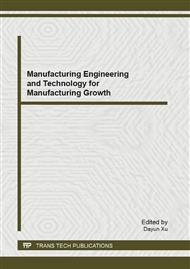[1]
X. Xiong, L.N. Mo. Performance Appraisal for Knowledge-based Employee. HLJ Foreign Economic Relations&Trade. 200(2011) 140-141.
Google Scholar
[2]
L.Y. Liu, Y. Ji, L. Zhou. Research on Role-based Performance Appraisal for Workshop. Manufacture Information Engineering of China. 40(2011) 6-10.
Google Scholar
[3]
E. Grigoroudis, E. Orfanoudaki, C. Zopounidis. Strategic performance measurement in a healthcare organisation: A multiple criteria approach based on balanced scorecard. Omega. 40(2012) 104-119.
DOI: 10.1016/j.omega.2011.04.001
Google Scholar
[4]
I.L. Wu, C.H. Chang. Using the balanced scorecard in assessing the performance of e-SCM diffusion: A multi-stage perspective. Decision Support Systems. 52(2012) 474-485.
DOI: 10.1016/j.dss.2011.10.008
Google Scholar
[5]
M. Wardell. Do the Key Performance Indicators (KPI) you are measuring say anything about the value of your business? Canadian Manager. 33(2008) 10-11.
Google Scholar
[6]
A.C. Kutlu. Fuzzy failure modes and effects analysis by using fuzzy TOPSIS-based fuzzy AHP. Expert Systems with Applications. 39 (2012) 61-67.
DOI: 10.1016/j.eswa.2011.06.044
Google Scholar
[7]
T. Paksoy, N. Pehlivan, C. Kahraman. Organizational strategy development in distribution channel management using fuzzy AHP and hierarchical fuzzy TOPSIS. Expert Systems with Applications. 39(2012) 2822–2841.
DOI: 10.1016/j.eswa.2011.08.142
Google Scholar
[8]
Y.C. Chou, C.C. Sun, H.Y. Yen. Evaluating the criteria for human resource for science and technology (HRST) based on an integrated fuzzy AHP and fuzzy DEMATEL approach. Applied Soft Computing. 12(2012) 64-7.
DOI: 10.1016/j.asoc.2011.08.058
Google Scholar
[9]
M.P. Xiong, X.H. Zhou, X.A. Duan. Modeling of Engineering R&D Staff Performance Appraisal Model Based on Fuzzy Comprehensive Evaluation. Systems Engineering Procedia. 4(2012) 236-242.
DOI: 10.1016/j.sepro.2011.11.071
Google Scholar
[10]
B.Y. Osnat, N. Avraham. Kluger. Strength-based performance appraisal and goal setting. Human Resource Management Review. 21(2011) 137-147.
DOI: 10.1016/j.hrmr.2010.09.001
Google Scholar
[11]
J.R. Spence, L. Keeping. Conscious rating distortion in performance appraisal: A review, commentary, and proposed framework for research. Human Resource Management Review. 21 (2011) 85-95.
DOI: 10.1016/j.hrmr.2010.09.013
Google Scholar


